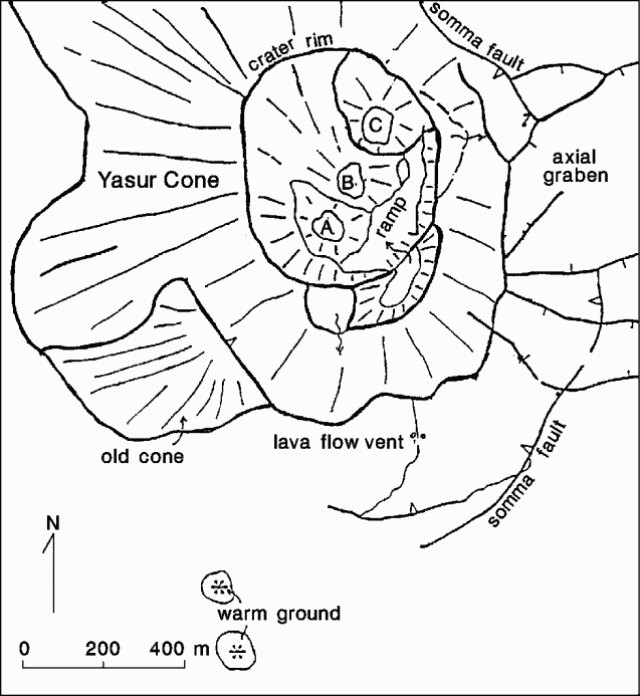Report on Yasur (Vanuatu) — November 1990
Bulletin of the Global Volcanism Network, vol. 15, no. 11 (November 1990)
Managing Editor: Lindsay McClelland.
Yasur (Vanuatu) Incandescent tephra ejection; small lava lakes; strong SO2 emission
Please cite this report as:
Global Volcanism Program, 1990. Report on Yasur (Vanuatu) (McClelland, L., ed.). Bulletin of the Global Volcanism Network, 15:11. Smithsonian Institution. https://doi.org/10.5479/si.GVP.BGVN199011-257100
Yasur
Vanuatu
19.532°S, 169.447°E; summit elev. 361 m
All times are local (unless otherwise noted)
The Vanuatu arc was visited by an ORSTOM mission 5-18 September. The following is modified from their report in the LAVE Bulletin.
Volcanic activity, consisting of block and ash emissions, and bubbling lava lakes, seemed slightly decreased since visits during 1988. The configuration of the main crater and its three principal sub-craters (A,B,C; figure 1) remained relatively unchanged. The depth from the summit to the base of the crater was estimated at >350 m, placing activity at or below sea level.
 |
Figure 1. Sketch map of Yasur showing the locations of the principal craters and sub-craters (from Nairn and others, 1988). |
In sub-crater A, a new lava lake (~20-25 m in length) was visible; strong turbulence in the lake due to rising gas bubbles caused lava to move N-S. Explosions at other vents (notably one in the S part of sub-crater B) corresponded with increased intensity of lava lake activity. Two other vents in sub-crater A had explosions that ejected ash and incandescent blocks. The blocks had loud detonations on impact.
Projectiles and night glow were visible from a lava lake in sub-crater B, hidden from view by a ridge. Explosions were identified from at least three vents, with frequencies of 1 explosion/5 minutes to 1/hour. Sub-crater C was less active, occasionally emitting puffs of ash or gas following explosions in sub-crater B. There were no visible shock waves or ejecta being deposited outside of the crater, as there were in 1988, suggesting a decrease in the intensity of activity.
Concentrations of 5-10 ppm SO2 were measured in the plume, 1 ppm from the ash plain below the plume, and 0.5 ppm, 3 km from the volcano. The SO2 flux was estimated to be 1,200 ± 600 t/d, based on the measured concentrations and a visual estimate of the plume volume. This is greater than the flux usually registered at other volcanoes in the Vanuatu arc (100-600 t/d). During 1987-88, vegetation in areas downwind from the volcano was affected by gas, ash, and acid rain, causing damage to gardens and coffee plantings.
Reference. Nairn, I.A., Scott, B.J., and Giggenbach, W.F., 1988, Yasur volcano investigations, Vanuatu, Sept. 1988: New Zealand Geological Survey Report, no. G134, 74 p.
Further Reference. Eissen, J.P., Monzier, M., Robin, C., Picard, C., and Douglas, C., 1990, Report on the volcanological field work on Ambrym and Tanna Islands (Vanuatu) from 2 to 25 September 1990: Rapport Missions Sci Terre Geologie-Geophysique - ORSTOM (Noumea), no. 22, p. 1-22.
Geological Summary. Yasur has exhibited essentially continuous Strombolian and Vulcanian activity at least since Captain Cook observed ash eruptions in 1774. This style of activity may have continued for the past 800 years. Located at the SE tip of Tanna Island in Vanuatu, this pyroclastic cone has a nearly circular, 400-m-wide summit crater. The active cone is largely contained within the small Yenkahe caldera, and is the youngest of a group of Holocene volcanic centers constructed over the down-dropped NE flank of the Pleistocene Tukosmeru volcano. The Yenkahe horst is located within the Siwi ring fracture, a 4-km-wide open feature associated with eruption of the andesitic Siwi pyroclastic sequence. Active tectonism along the Yenkahe horst accompanying eruptions has raised Port Resolution harbor more than 20 m during the past century.
Information Contacts: M. Lardy, ORSTOM, New Caledonia; B. Marty, CNRS, France; LAVE.

